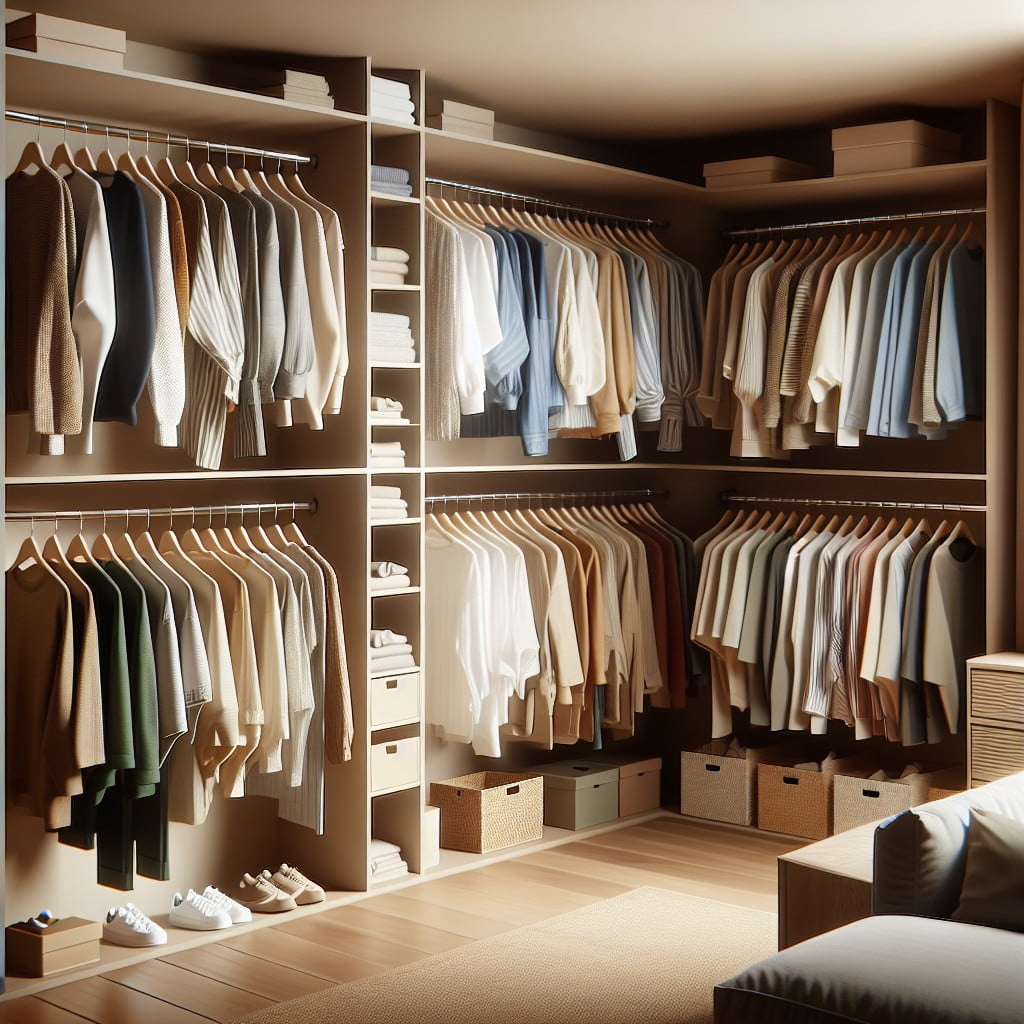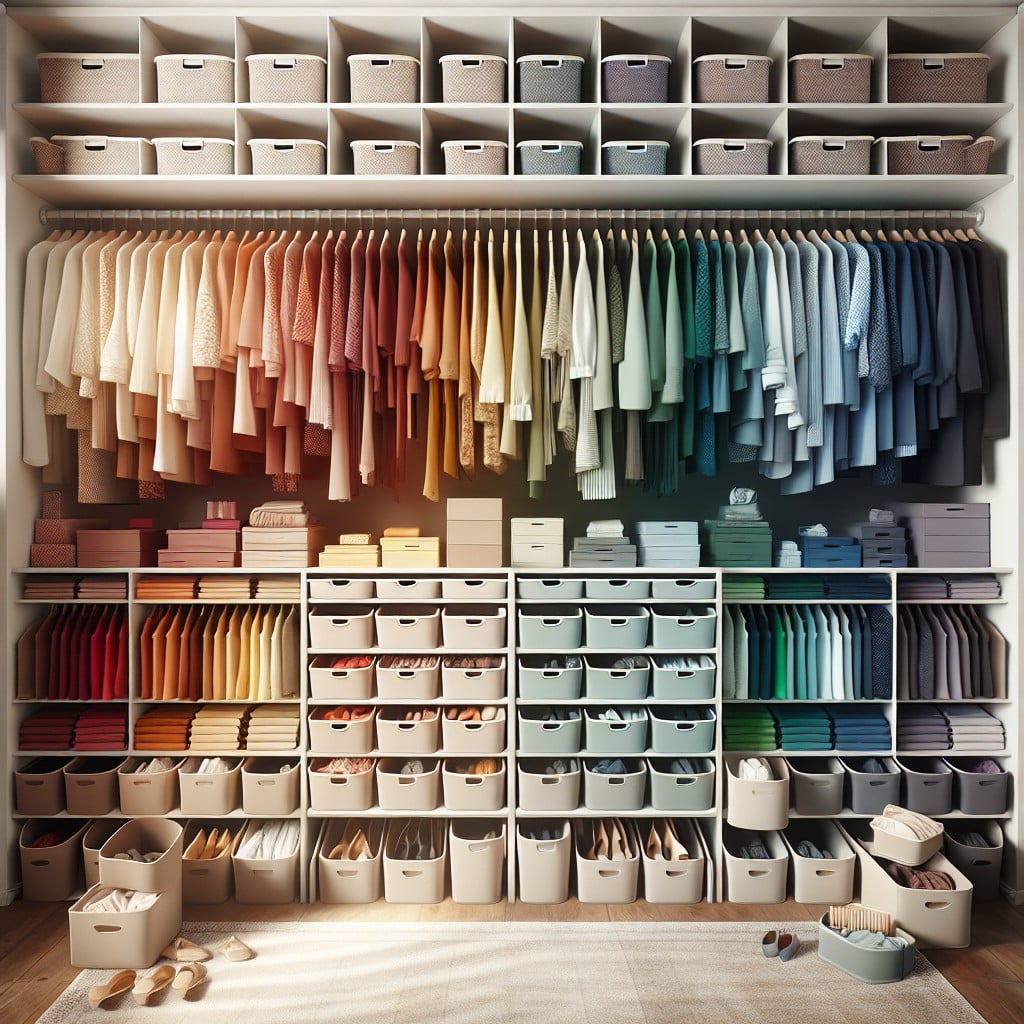Last updated on
Embarking on the journey to create a color-coordinated closet is less daunting than it appears because it simplifies decision-making, reduces clutter and infuses a sense of calm, a journey that this comprehensive “How-To” guide makes effortless.
Transforming your wardrobe into a color-coordinated haven not only streamlines your morning routine but also turns your closet into a visually appealing space.
Picture this: opening your closet doors to a harmonious arrangement of colors, where each garment and accessory has its rightful place, curated with a touch of aesthetic finesse using muted hangers and neutral storage solutions.
By aligning your clothing by color and prioritizing your most-worn hues, you’ll set the stage for effortless outfit selections.
Seasonal attire tucked away in distinctively colored bins further simplifies the process, ensuring your fashion choices are as organized as they are stylish.
Ready to delve into the details? Keep reading to transform your wardrobe into a masterpiece of organization and design.
Key takeaways:
- Opt for slim, non-slip hangers in muted tones.
- Select a neutral palette of storage bins and organizers.
- Color coordinate each type of clothing.
- Prioritize the colors you wear the most.
- Separate seasonal items in colored bins.
Neutralize Your Hangers

Starting with a uniform set of hangers creates a visually appealing base that allows the colors of your clothing to stand out.
Consider these points to streamline your closet’s look:
- Opt for slim, non-slip hangers in muted tones like black, white, or gray to ensure they don’t become the focal point.
- Consistency in hanger shape and color reduces visual clutter, making it easier to locate outfits.
- Use the same type of hanger for each clothing category to maintain a clean line and enhance organization.
- Reserve specialty hangers, such as wooden ones for suits or padded ones for delicate items, but keep the color uniform.
- Think of hangers as the canvas and clothes as the artwork; a consistent backdrop helps the main subject—in this case, your clothing—shine.
Select a Neutral Palette of Storage Bins and Organizers

Opting for storage solutions in shades such as white, beige, or gray creates a visually cohesive backdrop that allows your clothing’s colors to truly stand out. This consistent scheme not only provides a calming aesthetic but also enables quick identification and retrieval of items.
Consider these tips to integrate a neutral palette into your closet organization:
- Choose clear or solid-colored bins to segregate items while maintaining a uniform look.
- Select hangers in one color to keep the focus on the clothes and not the hangers.
- Utilize labels or tags in matching tones to mark contents without visual clutter.
- Opt for drawer dividers and shelf organizers in complementary neutral hues for a seamless blend.
Remember, the aim is to enhance functionality without sacrificing style—cohesive storage accessories accomplish both.
Color Coordinate Each Type of Clothing
Breaking down your wardrobe into distinct categories, such as tops, pants, dresses, and outerwear, provides an excellent foundation. Once you’ve grouped like items together, arrange each section by color. Begin with white and progress through greys, pastels, and into the deeper hues like navy and black.
For a harmonious transition, sort each color family from lightest to darkest. Sleeveless shirts, short-sleeved tees, and long-sleeved garments should also be ordered within their respective color sections. This not only makes choosing your outfit simpler but also creates an aesthetically pleasing spectrum that can make finding specific items faster. Remember the rainbow sequence, or ROYGBIV (Red, Orange, Yellow, Green, Blue, Indigo, Violet), as a guide to streamline your process.
It’s also helpful to decide on a consistent point when dealing with color gradients. Decide if you’re going to place darker or lighter hues in the front of the section, and stick with that method throughout your closet. This consistent approach reduces the time you spend searching and provides a cohesive look to your storage space.
Colors You Wear the Most Can Go Towards the Front of Your Closet
To streamline your morning routine, position the hues that dominate your wardrobe within easy reach. This strategy not only saves time but also ensures that your go-to pieces are always accessible.
Here are several tips to optimize your setup:
- Identify the shades you frequently choose, be it crisp whites, serene blues, or classic blacks.
- Position these items at eye level or on lower rods where you can effortlessly grab them.
- Keep the sequence logical: arrange the lightest to darkest shades or group by color family.
- Consider the convenience of daily wear: place often-worn garments front and center, relegating less-used items to the sides.
- Use uniform hangers for a clean look that keeps the focus on your clothes’ colors.
By customizing your closet based on your color preferences, you’ll not only save time but also create a more harmonious and functional wardrobe.
Separate Seasonal Items in Colored Bins
Maximizing your closet space means managing seasonal clothing effectively. Assigning distinct colors to bins for winter, summer, spring, and fall emphasizes organization at a glance and streamlines the transition between seasons.
Opt for cool blues or icy whites to represent winter wear, warm yellows or vibrant greens for summer outfits, spring might be signaled by pastel shades, while autumn could be marked with rich browns or oranges.
Keep these bins on higher shelves or under hanging clothes to keep them out of the way yet accessible when needed. This system not only tidies your space but also prevents out-of-season items from cluttering your daily wardrobe selection.
It’s a practical method to cycle your attire according to the weather without needing to sift through piles of clothing. Always label your bins; even though the colors serve as a quick visual reminder, labels solidify the organization.
Remember, consistency is key to maintaining a functional, color-coordinated closet year-round.
Use Color to Group Similar Footwear
Arranging shoes by color not only streamlines your selection process but also adds a visually appealing element to your closet. Here’s how to effectively implement this system:
- Start by grouping shoes by type—flats, heels, boots, sneakers, etc.
- Within each type, order them from light to dark, or in a spectrum that makes sense to you.
- If you have multiple pairs of a similar shade, rank them by frequency of use—with the most-worn shoes being more accessible.
- Store special occasion footwear separately, yet still sorted by color to maintain consistency without disrupting daily choices.
- Clear shoe boxes can protect your shoes from dust while keeping colors visible, aiding quick identification.
- For those without a range of colors, perform the same process but use shades and tones to create your order.
By treating your footwear like a palette, you’ll be able to pair your shoes with outfits more efficiently, ensuring you step out in style every time.
Prioritize Your Power Colors
Identifying and highlighting the hues you feel most confident and comfortable in can streamline your daily routine. These are what some fashion experts might call your “power colors”—the ones that enhance your mood and complement your skin tone.
- Arrange your closet so that garments in your preferred color spectrum are front and center, getting the prime real estate for easy access.
- Consider the visibility factor; if these shades are tucked away, they’re less likely to be worn.
- If limited by space, dedicate a specific shelf or section for these key items. This not only makes them easy to find but also serves as a visual reminder of these feel-good colors.
- Lastly, remember, while trends come and go, your personal palette is timeless. Giving it prominence ensures your clothing choices stay true to your style.
Sort Patterns By Their Primary Colors
When it comes to patterned clothing, the key is simplicity. Look for the dominant hue in each item and file it accordingly with its solid color counterparts. For instance, a striped blue and white shirt would join the blues. This method prevents visual clutter and streamlines your decision-making process.
However, if a piece is particularly multicolored and doesn’t have a clear primary color, designate a specific section for these items. This approach ensures that vibrant patterns don’t disrupt the flow of colors and makes it easier to locate that special piece when your outfit calls for a splash of mixed tones.
Remember to group like with like in terms of item type to maintain cohesion within your organizational system.
Maintain a Color-Organized Closet
Maintaining your color-coordinated closet requires a little discipline but yields great rewards in terms of ease and speed when choosing outfits. Here are some points to keep your color-coordinated system in top shape:
- Regularly declutter to avoid overcrowding, which can disrupt the visual flow of colors.
- After doing laundry, dedicate a few extra moments to place items back according to their color category.
- For new acquisitions, immediately assign a spot within the appropriate color section to prevent miscategorization.
- Once a month, do a quick scan to ensure everything is in its right place and to adjust as necessary due to seasonal changes or updated wardrobe choices.
- Consider using dividers or clear signage for seamless identification of different color sections.
With these practices, your color-organized closet will remain an efficient and aesthetically pleasing part of your daily routine.
FAQ
How do I color coordinate my closet?
To color coordinate your closet, simply categorize your items according to their types such as dresses, blouses, jackets and then, within each category, arrange them in the order of the colors of the rainbow – starting with white, tan, pink, then progressing to red, orange, yellow, green, blue, indigo, violet, and finally ending with brown, grey, and black.
Is it better to organize closet by color or style?
Organizing a closet by color is better as it streamlines the search process, enhancing your style and saving you time.
What order do colors go in?
The order of colors typically goes as white, cream, pink, red, orange, yellow, green, blue, indigo, violet, brown, gray, and black, incorporating the ROYGBIV system.
What is the color order of the home edit closet?
The color order of the Home Edit closet follows the ROYGBIV method, which represents the sequence: red, orange, yellow, green, blue, indigo, and violet.
What are the benefits of having a color coordinated closet?
A color-coordinated closet simplifies the process of choosing outfits, enhances the aesthetic appeal of your wardrobe, promotes a clean and organized environment, and may help identify missing or over-represented colors in your clothing items.
How does the psychology of color apply to organizing a closet?
The psychology of color, which suggests that different colors can evoke certain emotions, can be strategically applied to organizing a closet by choosing color schemes that evoke desired feelings such as calm, energy, or happiness.
Can color coordination methods be applied to different types of closets (walk-in, wardrobe, etc.)?
Yes, color coordination methods can be applied to any type of closet, including walk-in closets and wardrobes.
Recap:




